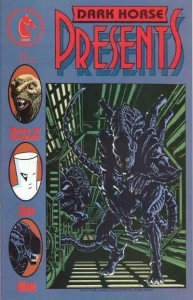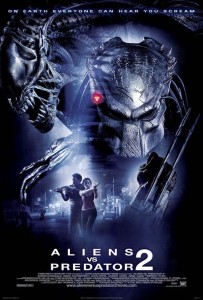In a multi-part series, Comic Book Film Editor William Gatevackes will be tracing the history of comic book movies from the earliest days of the film serials to today’s big blockbusters and beyond. Along with the history lesson, Bill will be covering some of the most prominent comic book films over the years and why they were so special. Today, we talk about a film franchise based on a comic book featuring characters created in the movies, Aliens vs. Predator.
Alien was not adapted from comic books. It was an original story from Dan O’Bannon and script from O’Bannon and Ronald Shusett.
Predator was also not adapted from comic books. It sprung from the minds of screenwriters Jim and John Thomas.
So, why am I talking about the Aliens Vs. Predator franchise in a comic book film column? Because if a comic company didn’t decide to pit the two against each other, the film franchise might not have existed.
 Dark Horse Comics is a small, independent publisher based out of Portland, Oregon that was founded in 1986. Like many other companies that sprung up around the same time, Dark Horse’s output was unique and eclectic, typically printed in black and white, and featured a selection of titles that just didn’t fit in elsewhere, titles such as Concrete, Trekker, Black Cross and the anthology Dark Horse Presents.
Dark Horse Comics is a small, independent publisher based out of Portland, Oregon that was founded in 1986. Like many other companies that sprung up around the same time, Dark Horse’s output was unique and eclectic, typically printed in black and white, and featured a selection of titles that just didn’t fit in elsewhere, titles such as Concrete, Trekker, Black Cross and the anthology Dark Horse Presents.
If the company kept up with this publishing plan, it might not be around today. But in 1988, Dark Horse went into the licensing business. It went to 20th Century Fox to license that studio’s properties. From the studio, it got permission to adapt the Alien franchise, which at the time was riding high from its second installment, James Cameron’s Aliens, and Predator, which was Fox’s box office hit from the year before.
It’s these licenses that helped Dark Horse become one of the big four publishers today. The company started publishing books in each franchise the following year, and each title was a resounding success. They parlayed that success into acquiring more licenses, such as Buffy the Vampire Slayer and Star Wars, and developing original, creator owned properties such as Sin City and Hellboy.
This success would have been enough to put Dark Horse on the map. However, an idea came out of a corporate brainstorming session that was sheer genius. They decided to create a line of books where the Aliens would face off against the Predators across the universe, with humans typically caught in the middle. This idea was a fresh one in the world of comics. Many companies would cross licensed characters over with their own stable of characters, but not with each other.
 The first Alien vs. Predator story debuted in the aforementioned Dark Horse Presents, issue #34, cover dated November 1989. Over the next 21 years, Dark Horse would publish eight series where the alien hunters would face off against each other, one series where the pair would battle with another licensed franchise, The Terminator, two intercompany crossovers with Image Comics where characters from the latter’s Darkness and Witchblade series’ got caught in the war, and one intercompany crossover with DC Comics where Superman and Batman teamed to stop the carnage the Aliens and Predators created.
The first Alien vs. Predator story debuted in the aforementioned Dark Horse Presents, issue #34, cover dated November 1989. Over the next 21 years, Dark Horse would publish eight series where the alien hunters would face off against each other, one series where the pair would battle with another licensed franchise, The Terminator, two intercompany crossovers with Image Comics where characters from the latter’s Darkness and Witchblade series’ got caught in the war, and one intercompany crossover with DC Comics where Superman and Batman teamed to stop the carnage the Aliens and Predators created.
However, while the Alien, Predator, and Aliens vs. Predator franchises were doing great in the comics, the film franchises were put into mothballs. The Predator franchise never survived the poorly received Predator 2 in 1990, and it was 1997’s Alien: Resurrection that put that franchise on the shelf. Of course, nothing that has ever sold tickets will stay dormant for long, and seeing how well pairing of the alien monsters went in the comics, Fox decided to try the same gambit in the films.
 2004’s Alien vs. Predator might have been inspired by the comic book pairing, but it didn’t adapt any of the comic book stories. The film was set on Earth in the present day, unlike the comics where it was set in a dystopian future where Aliens conquered the Earth. The plot involved an ancient pyramid found under the ice on an island just off the coast of Antarctica. A group of scientists working for the Weyland Corporartion go there to investigate. Unfortunately, the scientists are soon joined by a ship full Predators, who have also come to examine the site. It turns out that the pyramid was home to a dormant race of Xenomorphs, a race that the investigating humans inadvertently awakened. The humans soon find themselves as pawns in the of the ritual battle between the Aliens and the Predators.
2004’s Alien vs. Predator might have been inspired by the comic book pairing, but it didn’t adapt any of the comic book stories. The film was set on Earth in the present day, unlike the comics where it was set in a dystopian future where Aliens conquered the Earth. The plot involved an ancient pyramid found under the ice on an island just off the coast of Antarctica. A group of scientists working for the Weyland Corporartion go there to investigate. Unfortunately, the scientists are soon joined by a ship full Predators, who have also come to examine the site. It turns out that the pyramid was home to a dormant race of Xenomorphs, a race that the investigating humans inadvertently awakened. The humans soon find themselves as pawns in the of the ritual battle between the Aliens and the Predators.
The film presented itself as a prequel to the Alien Franchise. It was written by Alien‘s scribes O’Bannon and Shushett, featured the Weyland Corporation, which played a large part in the franchise and cast Lance Henrikson, who played an android named Bishop in Aliens, as Charles Bishop Weyland, the owner of the corporation. However, some fans considered the fact that humans made contact with the Aliens years before Ripley and company did took away a lot of atmosphere of the Ridley Scott original.
However, this was not enough to keep audiences away. Alien vs. Predator tripled it’s production budget and guaranteed the sequel it hinted at in the closing moments. That sequel, Alien vs. Predator: Requiem, arrived in 2008, giving purists more to complain about.
 This film continues right after Alien vs. Predator, as a Alien bursts out of a dead Predator’s chest on the spaceship ride home. This causes the ship to crash land outside Gunnison, Colorado. The hybrid Predator/Alien escapes and starts infecting townsfolk with alien embryos. A Predator “cleaner” answers the ships distress call and begins hunting the hybrid through the area. Once again, the humans become pawns in the cat and mouse between the hybrid and his Aliens and the Predator.
This film continues right after Alien vs. Predator, as a Alien bursts out of a dead Predator’s chest on the spaceship ride home. This causes the ship to crash land outside Gunnison, Colorado. The hybrid Predator/Alien escapes and starts infecting townsfolk with alien embryos. A Predator “cleaner” answers the ships distress call and begins hunting the hybrid through the area. Once again, the humans become pawns in the cat and mouse between the hybrid and his Aliens and the Predator.
If having Aliens come in contact in a secluded frozen wasteland was enough to raise hardcore fans ire, having them traipse around in the American Rockies was enough to drive them insane.
The film, like its predecessor, tripled its budget. However, this was only just enough to make it the lowest grossing film in any of the franchises, and it was also the worst reviewed of any of the Alien or Predator film. To date, there has been no movement on a second sequel to this franchise. Instead, we got a trip to the Predator homeworld in Predators, and a ipso facto prequel to Alien with Prometheus.
Up next, we talk about another Dark Horse success story, Hellboy, at its trips to the silver screen.





HISTORY OF THE COMIC BOOK FILM: Versus http://t.co/liH9TsSgrA
Richard Boomvavavoom Boom liked this on Facebook.